This post may contain affiliate links. For more information, please see our affiliate policy.
The most Perfect Roast Turkey recipe relies on dry-brining and butter-basting for the juiciest, most delicious turkey you’ve ever had. Save your pan drippings too for an easy classic gravy recipe.
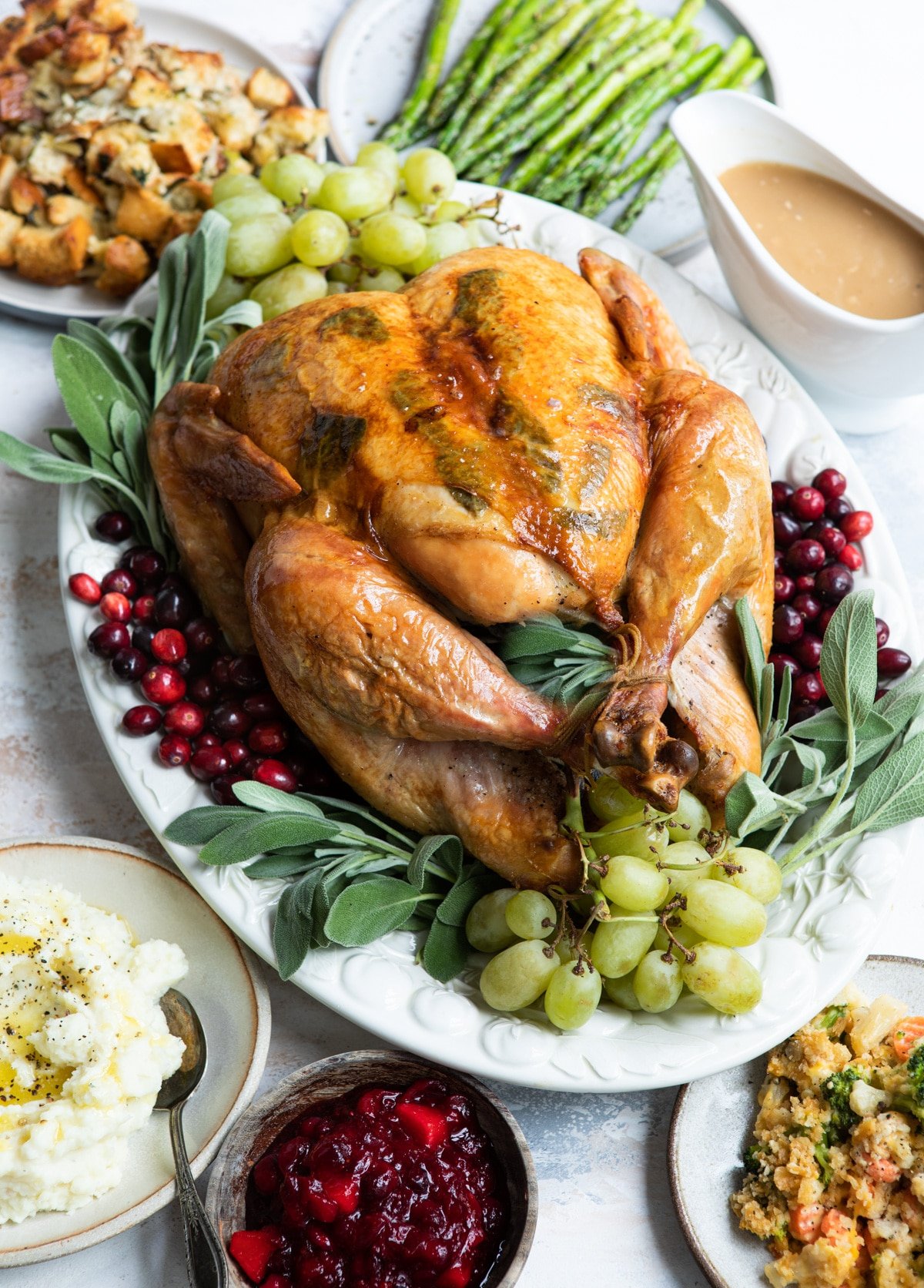
My idea of a perfectly roasted turkey involves juicy meat, butter-crisp skin, and plenty of flavor.
Luckily, there’s a way to get all three of those things without a giant bucket of salted water (taking up precious fridge space) or a vat of boiling oil (too risky and unpredictable.)
Whether you’re a first-time turkey roaster or a seasoned Thanksgiving host, this recipe is easy to follow and always makes people come back for seconds.
Table of Contents
Recipe ingredients
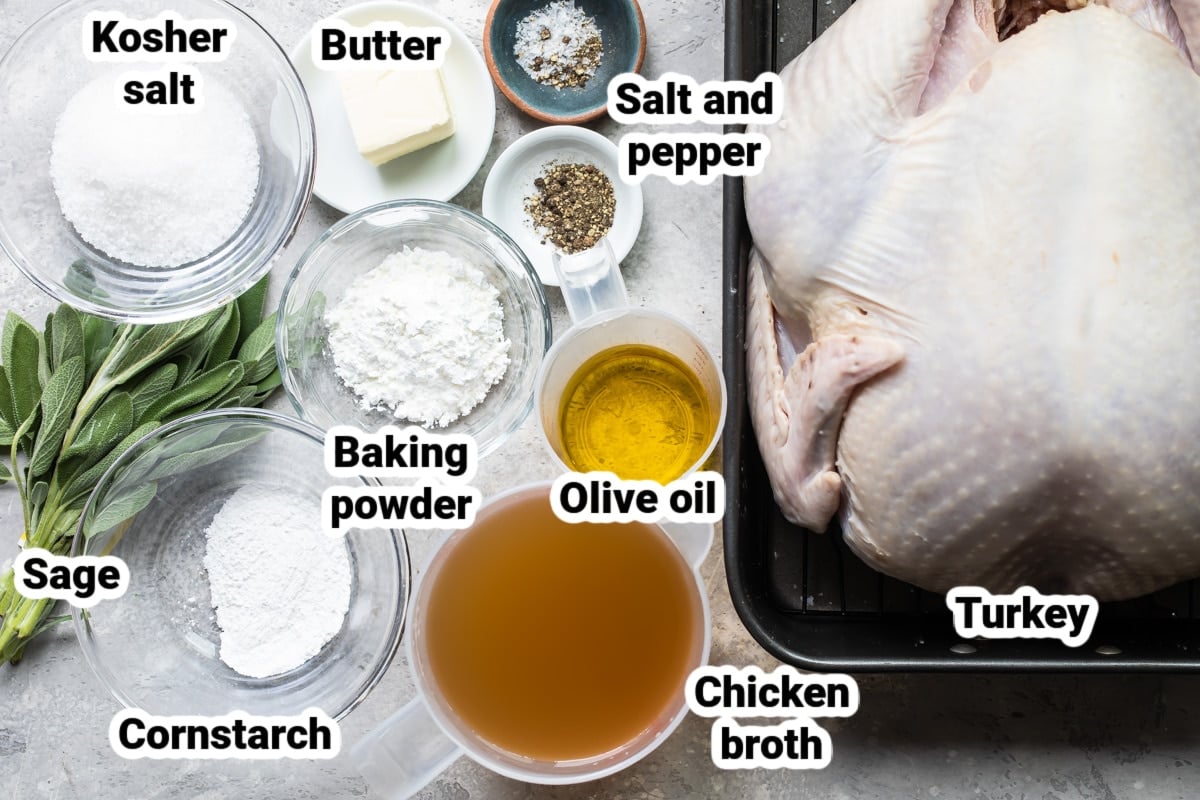
At a Glance: Here is a quick snapshot of what ingredients are in this recipe.
Please see the recipe card below for specific quantities.
Ingredient notes
- Turkey: Look for a turkey with the words “no salt added” on the label. Stay away from “self-basting” or Kosher turkeys which are already injected with a brine. The best (and safest) way to thaw a frozen turkey is slowly in the refrigerator over the course of several days (about 4 days for a 15-pound turkey). Never thaw a turkey using warm/hot water, in the microwave, or at room temperature, all of which let bacteria grow before the turkey is thawed.
- How much turkey: Plan on 1 ¼ pounds per person. If you can’t find a turkey small enough for your group, consider a turkey breast instead. And if you’re feeding a large group, consider a couple of medium or large turkeys rather than an enormous one (it is easier to thaw and cook a couple of average birds rather than the biggest one you can find).
| Servings | How much turkey |
| 2-3 adults | 4 pounds |
| 3-4 adults | 5 pounds |
| 5-6 adults | 8 pounds |
| 7-8 adults | 10 pounds |
| 8-10 adults | 13 pounds |
| 10-12 adults | 15 pounds |
| 12-15 adults | 20 pounds |
| 15-20 adults | 25 pounds |
| 20-25 adults | 32 pounds |
- Kosher salt: Used for dry-brining (aka pre-salting). The salt draws out the extra moisture in the turkey, forms a salt solution on the outer layer of the bird, and then is reabsorbed back into the meat to season it. For a wet-brine recipe, see my post on how to brine a turkey. Don’t substitute standard table salt for the Kosher salt because it is much finer and much saltier.
- Baking powder: Baking powder dries out the outer layer of the turkey resulting in deliciously crispy skin.
- Chicken broth: Homemade chicken broth, or turkey broth, if you’re one step ahead of things. If you like, you can simmer the neck and gizzards in water while the turkey roasts to make a quick version of turkey broth (discard the liver). Store-bought works, too.
- Cornstarch: My trick for making an easy gravy that’s also gluten-free.
Step-by-step instructions
Brine the turkey:
- Rinse the thawed turkey well inside and out under cold running cold water. Set on a rack set over a rimmed baking sheet. Remove any excess fat or pin feathers and pat dry with paper towels.
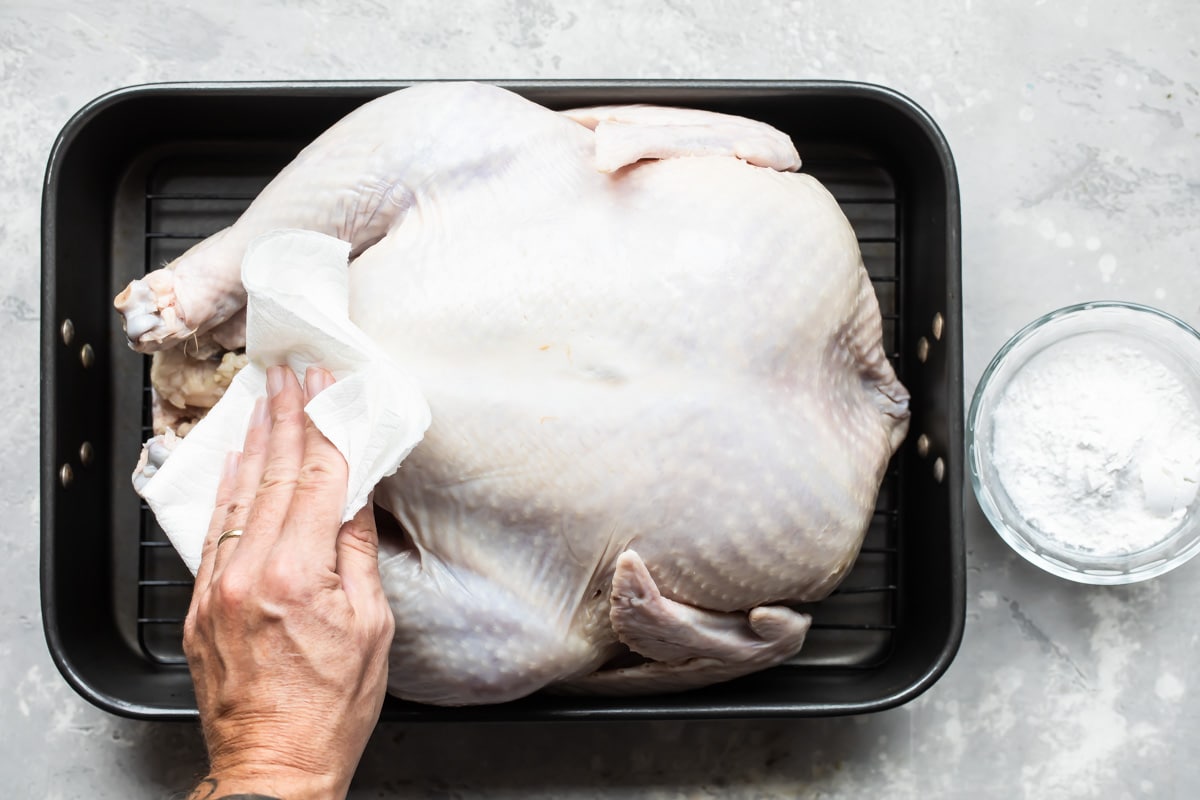
- In a small bowl, add kosher salt and baking powder and stir to combine. Sprinkle the salt mixture over the bird. Coat well, stopping before a crust forms (you may not need all of the salt mixture). Transfer the turkey to a rimmed baking sheet and refrigerate, uncovered, for 12 to 24 hours (or loosely cover and refrigerate for up to 3 days). Remove the turkey from the refrigerator and let sit at room temperature 2 hours prior to roasting.
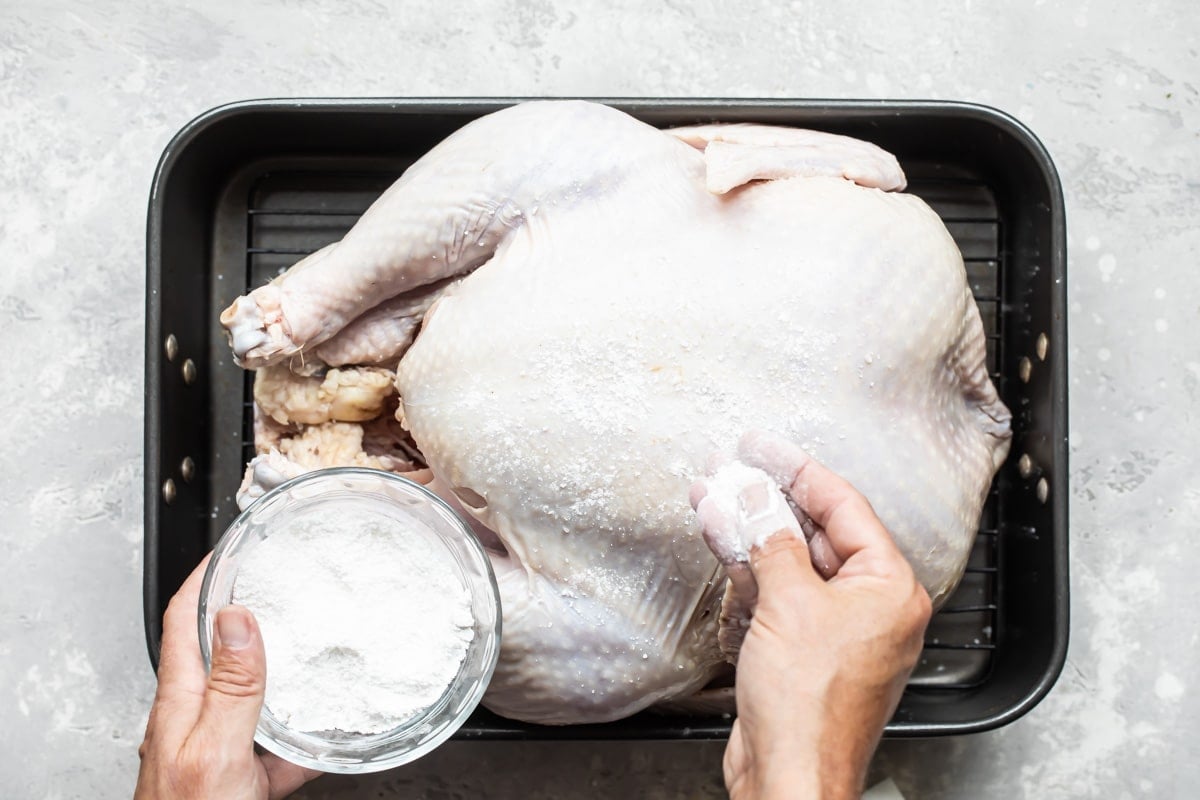
Roast the turkey:
- Preheat the oven to 425 degrees and place a rack in the lower third of the oven. In a small bowl, stir together the melted butter and olive oil (for basting) and set aside. Gently slide your fingers between the skin and the breast of the turkey to loosen the skin. Spread half of the softened butter between the breast and the skin. Arrange twelve sage leaves evenly between the skin and the breast. Place the remaining sage in the cavity. Season with black pepper, including the cavity.
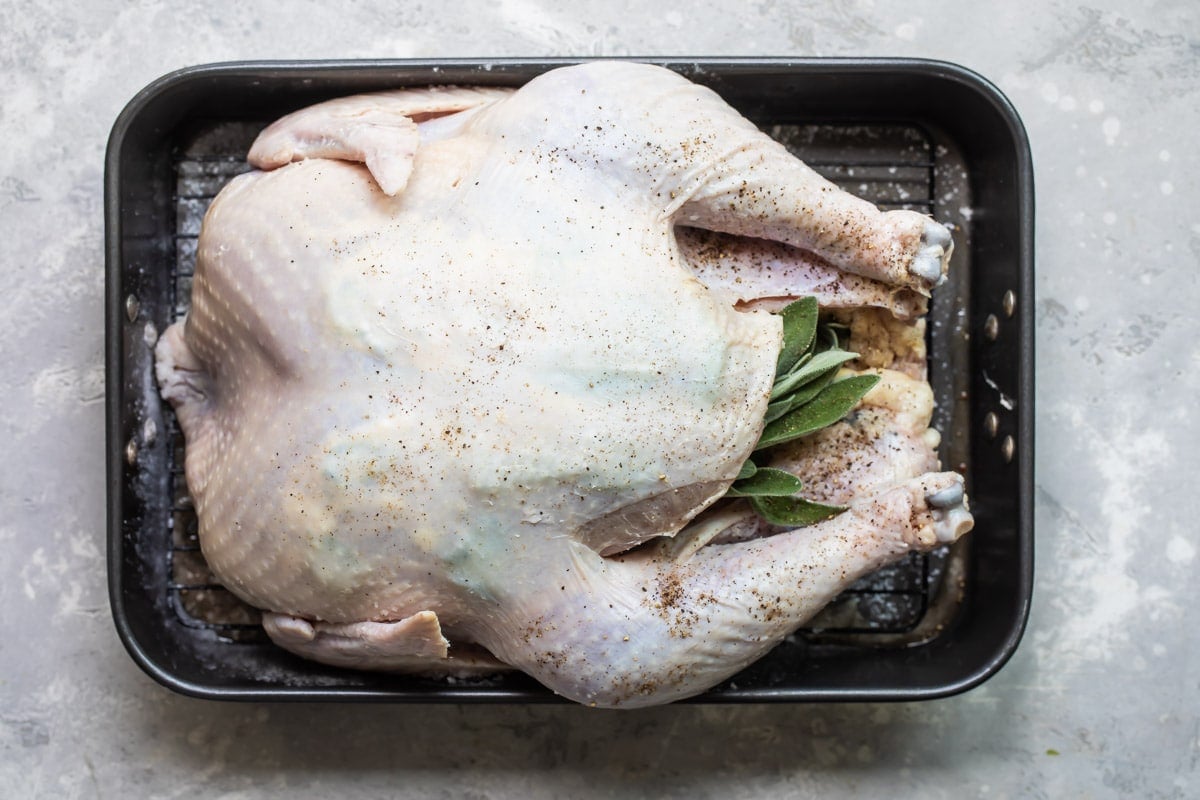
- Truss the turkey, place the bird on it’s back, and rub the remaining 2 tablespoons softened butter all over. Place in a roasting pan breast-side up.
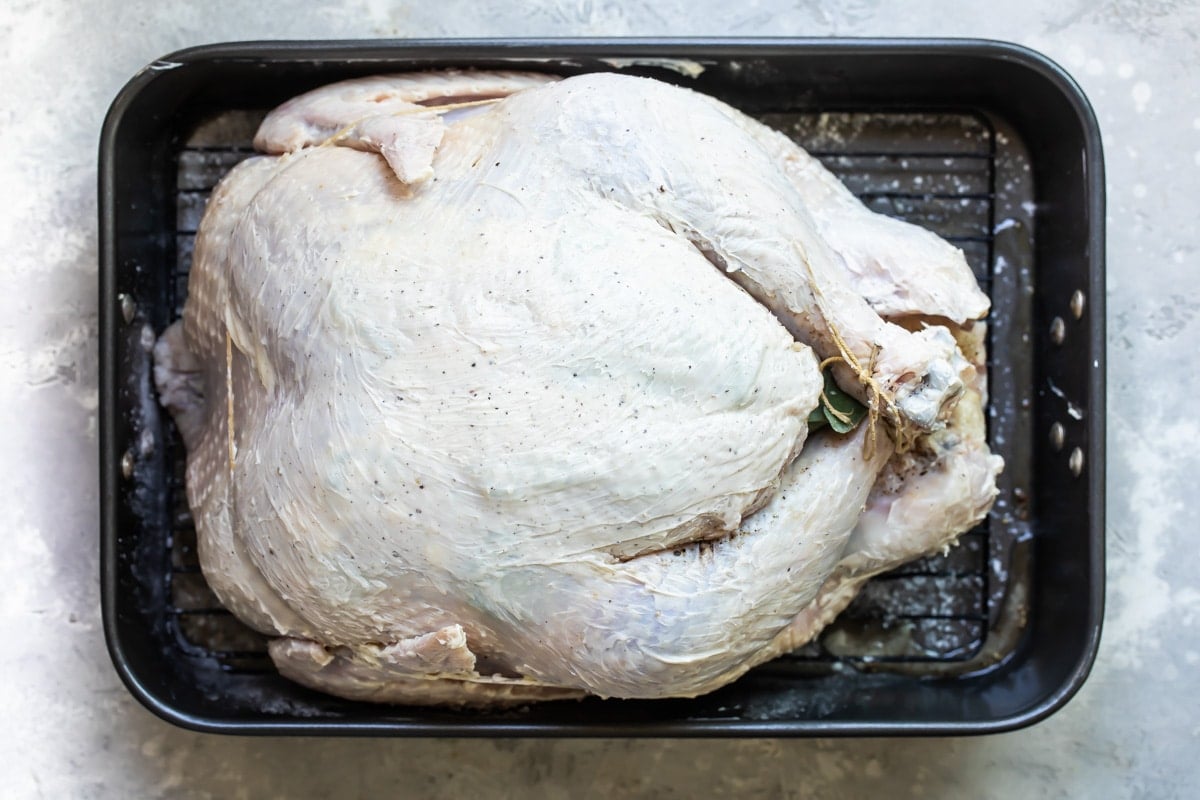
- Pour 1 inch water into the bottom of the roasting pan. Lower the oven temperature to 325 degrees. Roast the turkey for 3 to 3 ½ hours, basting every hour with the butter and oil mixture. Add additional water to the pan as needed.
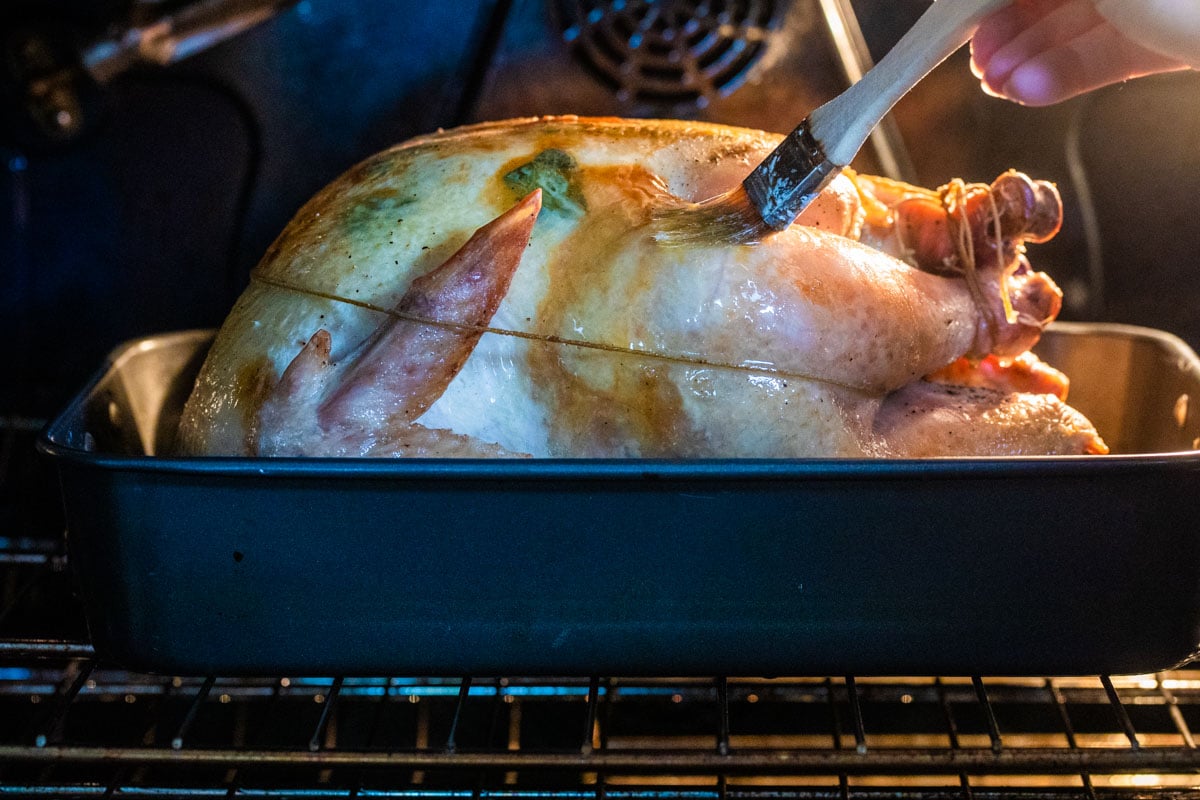
- Begin testing for doneness after 2 ½ hours. A thermometer inserted into the thickest part of the thigh should reach 165 degrees, and the juices should run clear. Transfer the turkey to the carving board and tent with aluminum foil and allow to rest for 30 minutes.
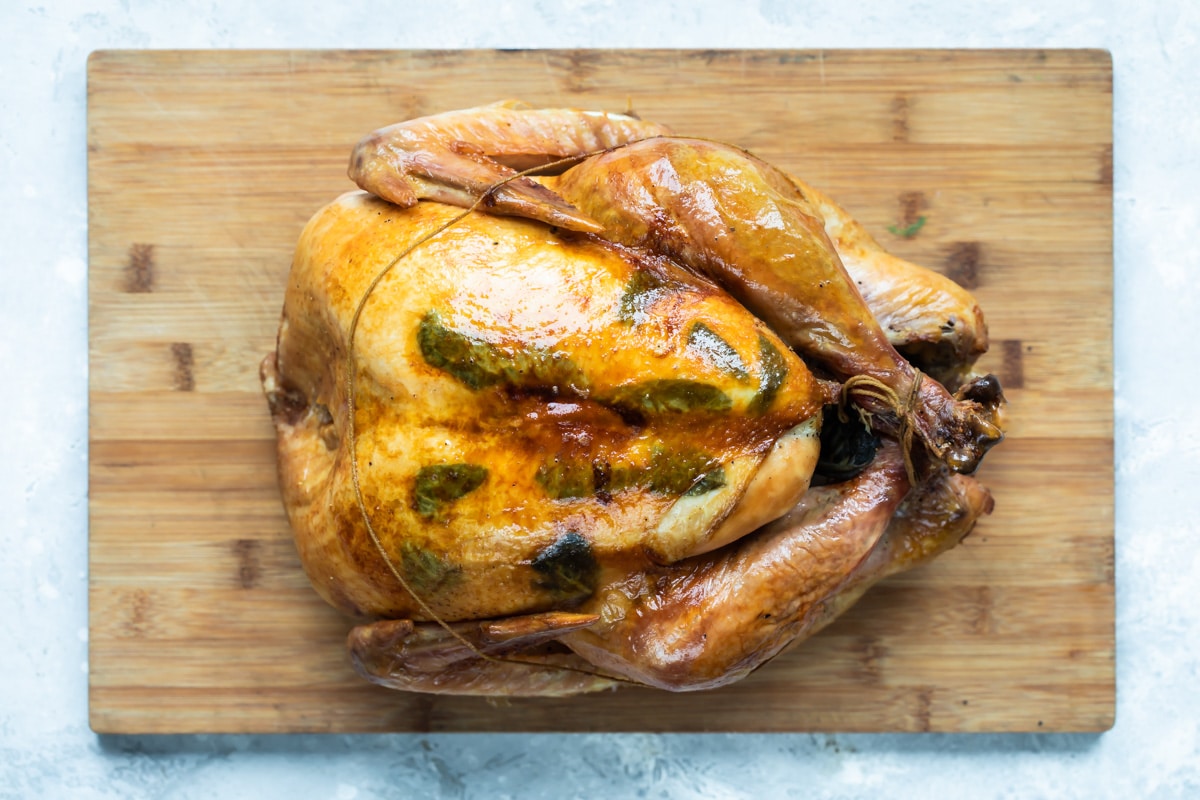
Make the gravy:
- Place the roasting pan with drippings over 2 burners and turn heat to medium-high. Add broth and bring to a simmer, scraping up the browned bits off the bottom of the pan.
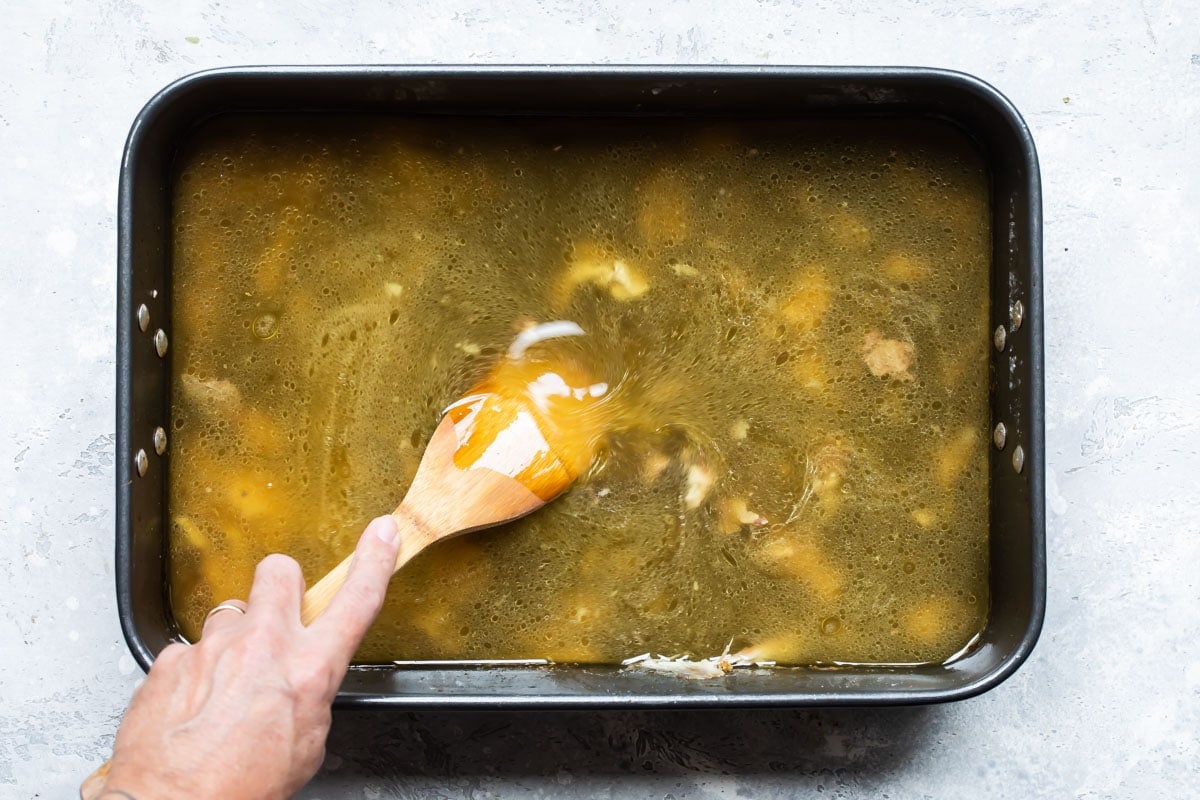
- Pour the contents through a fine-mesh strainer set over a large bowl. Using a large flat spoon, skim off and discard the layer of fat that floats to the surface, or pour the liquid into a fat separator and pour off the liquid, leaving the grease behind.
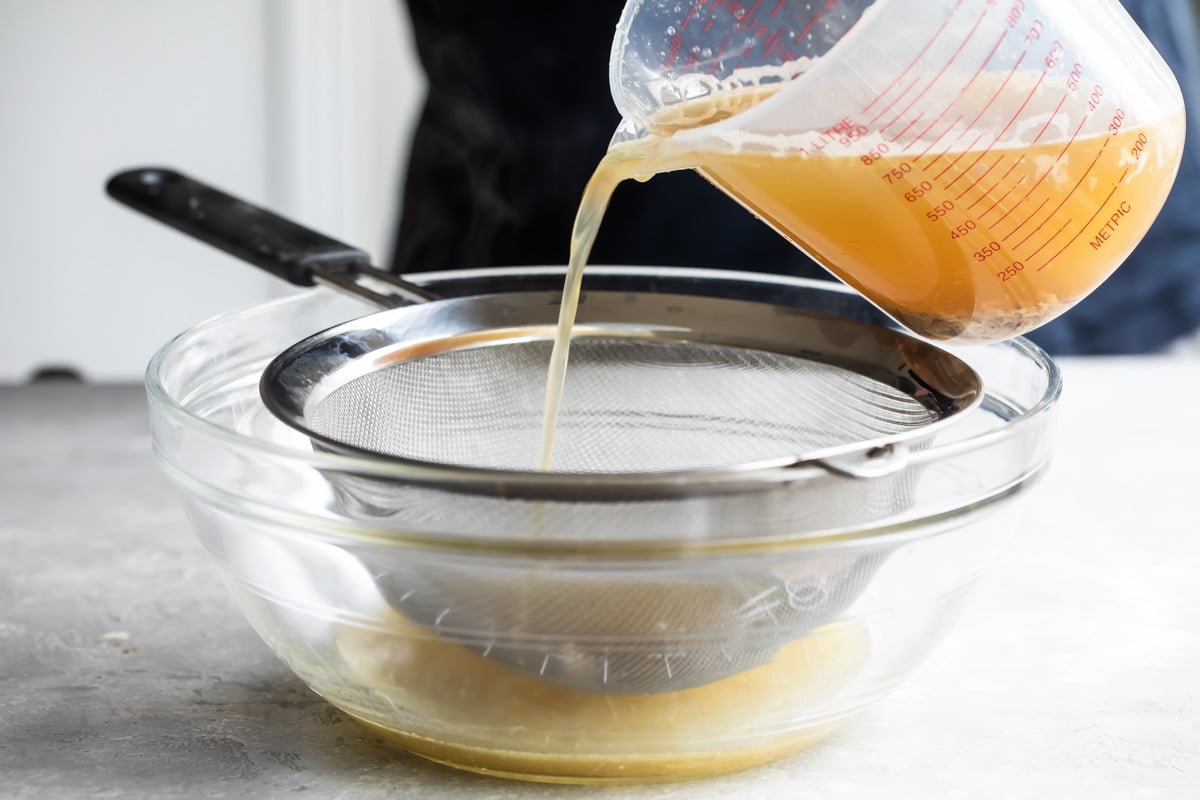
- Transfer the liquid to a saucepan, place over medium-high heat, and simmer briskly. In a small bowl, add some of the liquid and the cornstarch and whisk together to make a slurry. Gradually whisk the slurry into the simmering liquid, then cook until the gravy thickens, about 5 minutes. Season to taste with salt and pepper.
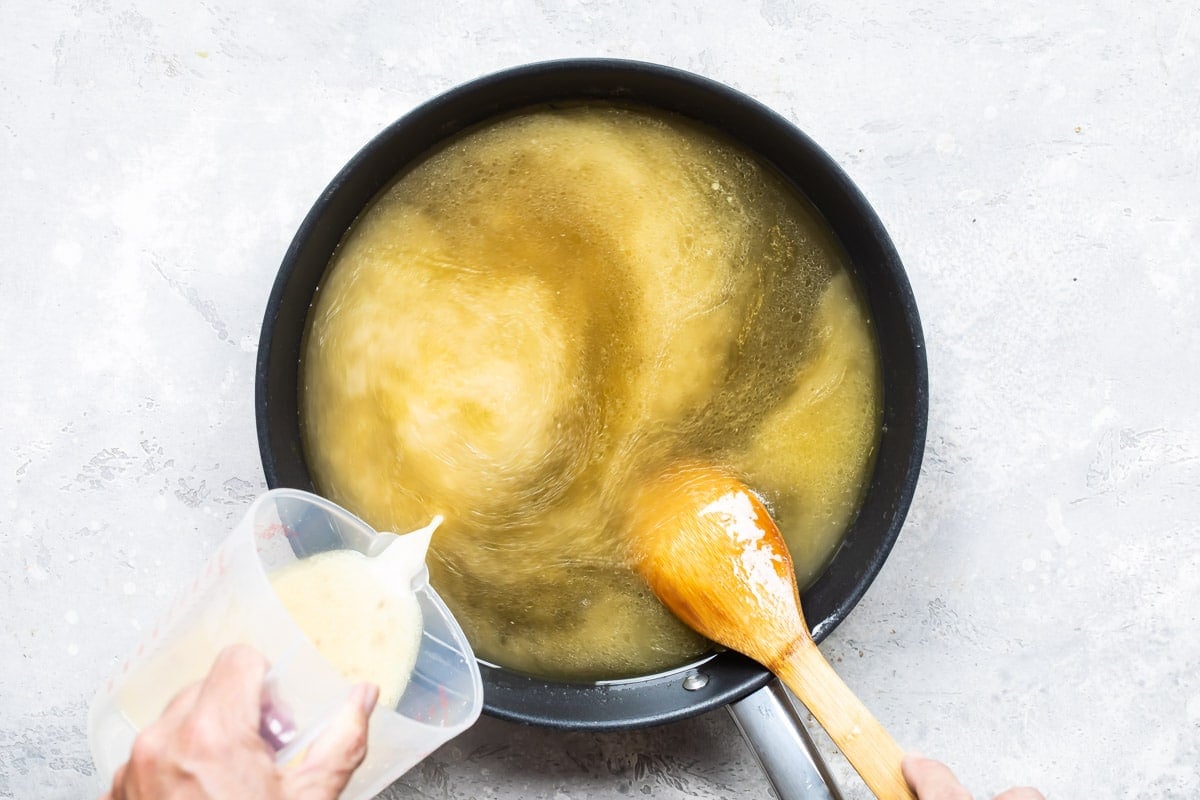
- Remove the truss and carve the turkey. Carving one side at a time, cut through the shoulder joint to remove the wing. Cut through the thigh joint to remove the whole leg. Cut through the joint that separates the drumstick from the thigh. To remove the breast, cut along the breastbone while following the curvature of the bones. Place the breast on the cutting board, then slice the breast meat on an angle.
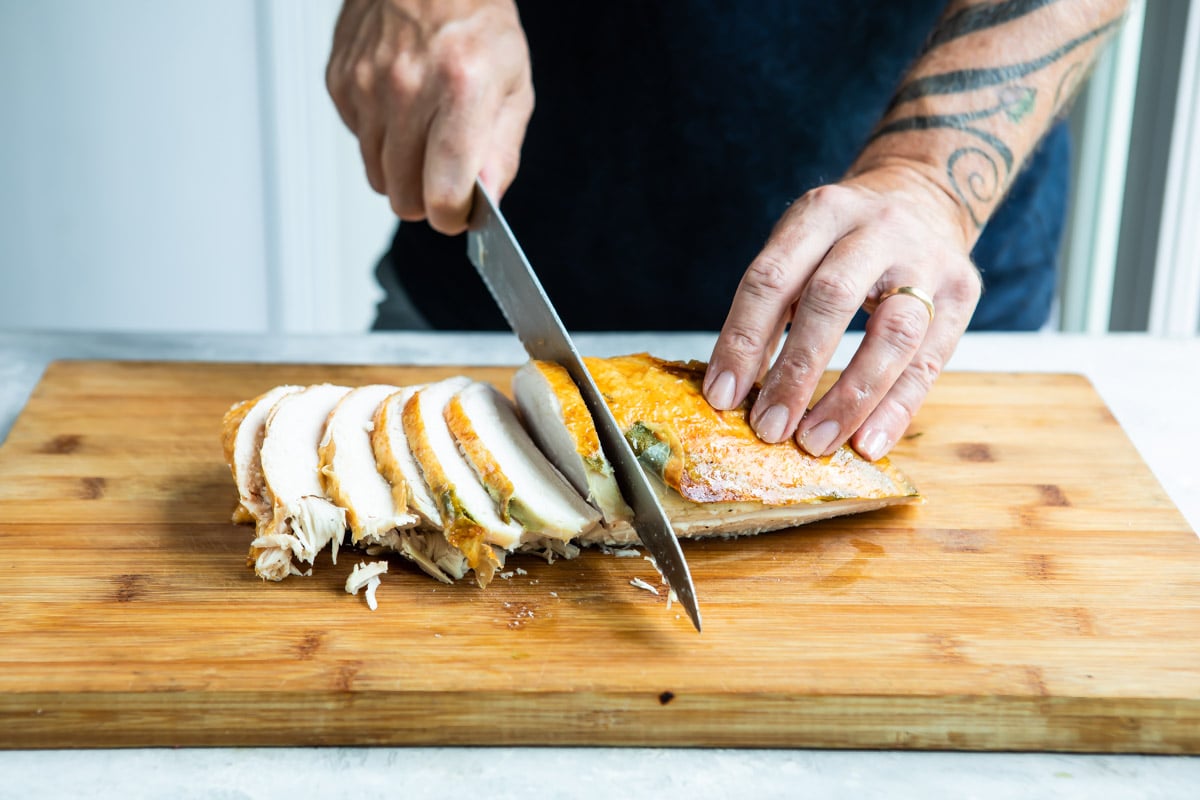
Serve the turkey:
- Serve the turkey with the gravy and all your favorite sides.
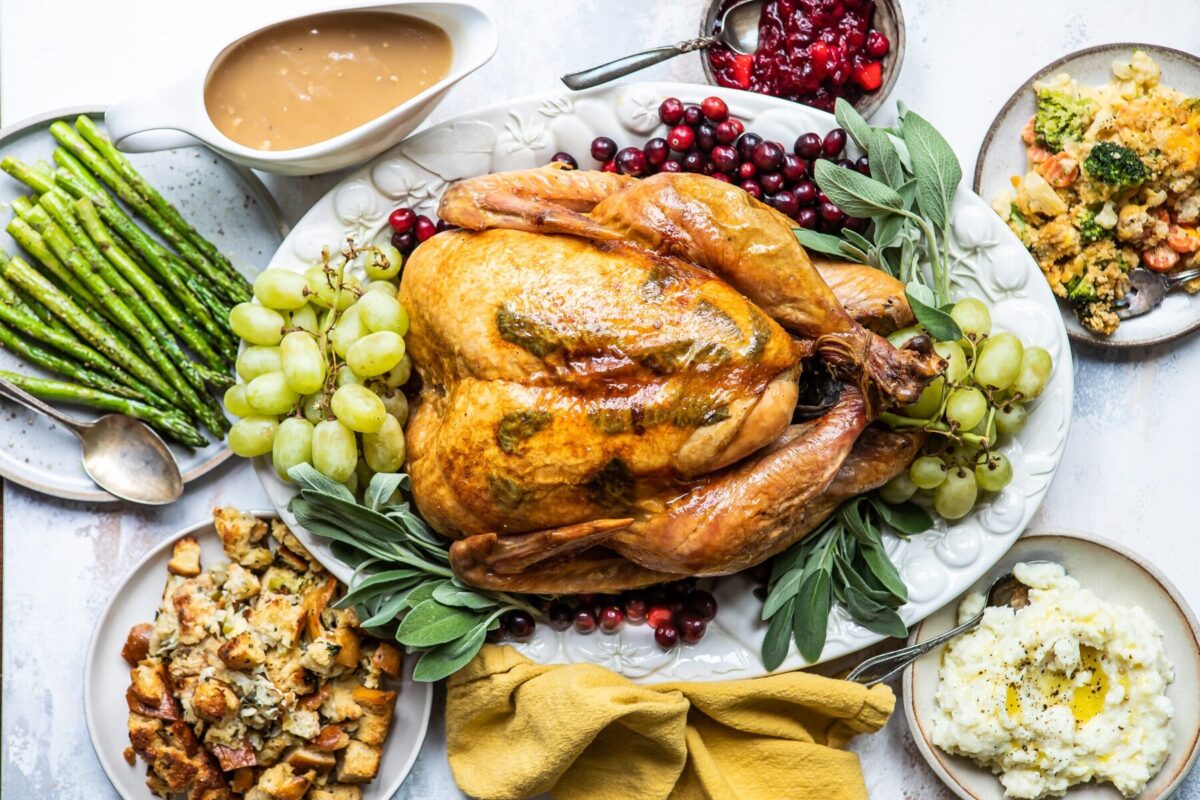
Do you need an instant-read thermometer?
Because roasting times may vary, the best way to tell if a turkey is done is with a good instant-read thermometer. I love my Thermapen One from ThermoWorks and it’s one of my most used cooking tools. I get nearly instant, extremely accurate results every time. In fact, we named it the top pick in our roundup of the best instant-read thermometers.
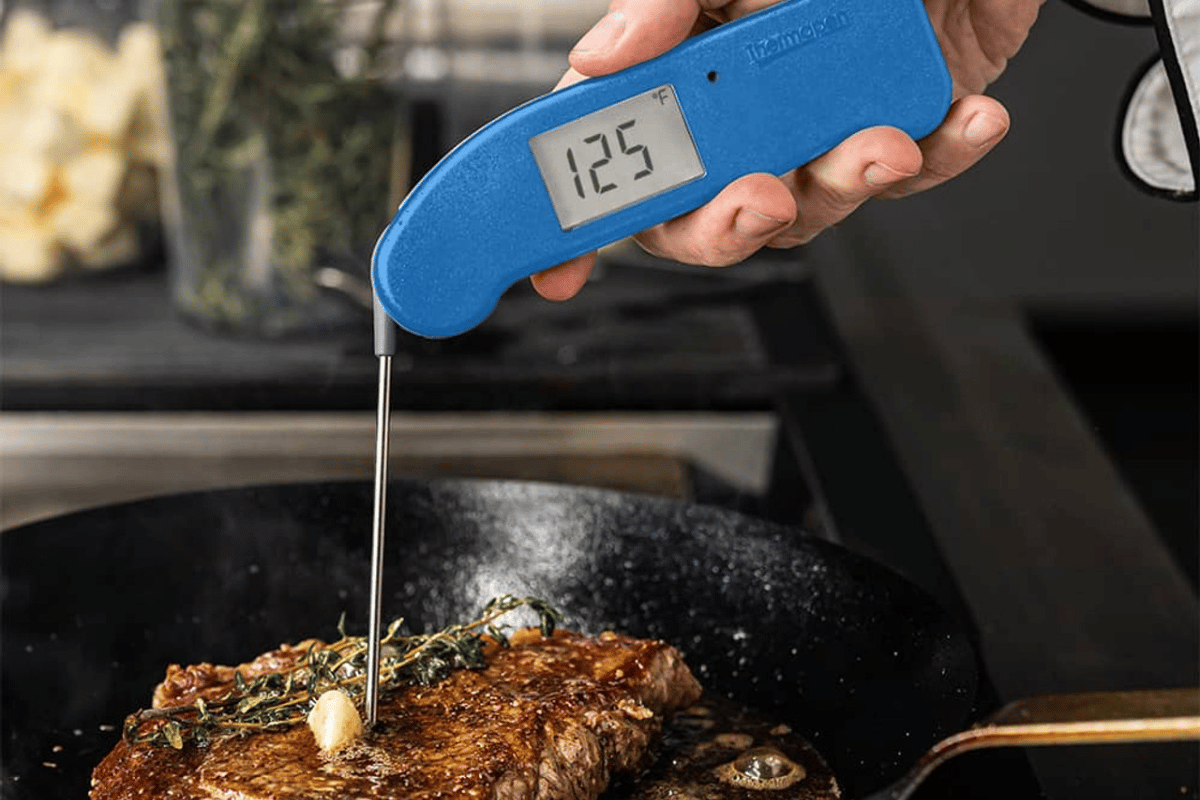
It’s a bit pricey and you can get it for $99 at ThermoWorks. It does go on sale every so often, but if you want a more budget-friendly option, I also like the ThermoPop, which is only $15.99 at ThermoWorks and it makes a great gift!
Recipe tips and variations
- Yield: Plan for 1 ¼ pounds turkey per person (some of the weight is from bones). This recipe assumes a 15-pound bird which will feed about 12 people (about 1 ½ cups turkey per person or 18 cups total). The math is: 12 people x 1.25 pounds per person = 15-pound turkey.
- Storage: Store leftovers covered in the refrigerator for up to 4 days.
- Make ahead: Get a jump start on your Thanksgiving prep with my easy Make Ahead Turkey recipe. Roast, carve, and freeze the turkey in its juices. Then thaw, reheat, and make the gravy.
- Roasting times may vary: After all, you may be cooking a slightly smaller or larger turkey. An unstuffed turkey takes about 15 minutes per pound when roasted at 325 degrees. However, the best way to tell if a turkey is roasted through is with a good meat thermometer (165 degrees at the thickest part of the thigh).
- Table-side carving: Follow this method if you prefer to carve the turkey at the table, rather than handle everything backstage. Just above the thigh and shoulder joints, carve a deep horizontal cut through the breast toward the bone to create a base cut. Starting near the breastbone, carve thin slices vertically, cutting downward to end each slice at the base cut.
- Slow Cooker Turkey Breast: This recipe delivers a delicious, tender bird without taking up any oven space.
- Ultimate Turkey Guide: Cook your best Thanksgiving menu (or Sunday dinner) ever. Brush up on how to buy, thaw, brine, and cook a turkey, plus learn how easy it is to make turkey broth from bones and turkey gravy from pan drippings.
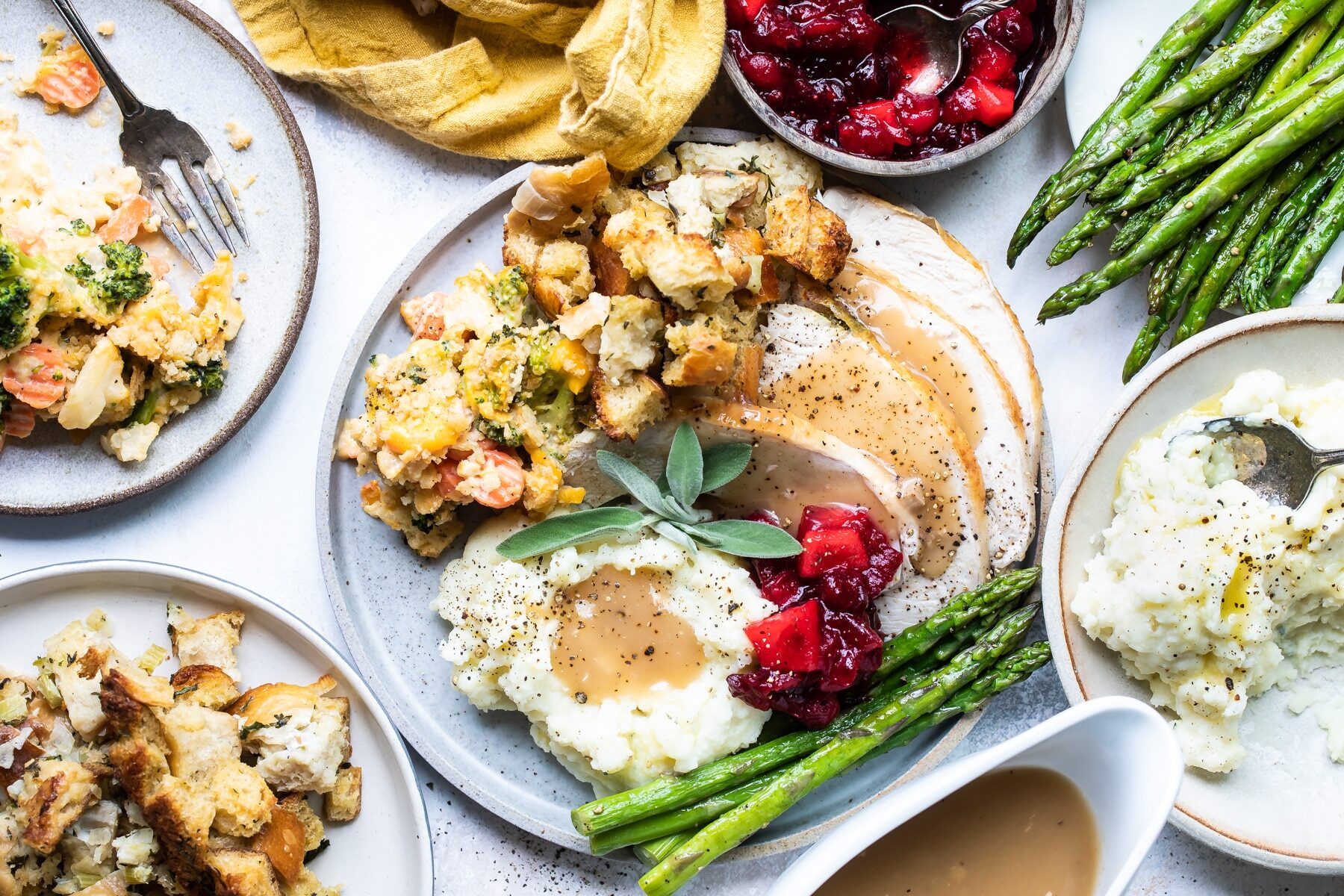
Frequently Asked Questions
Plan on 1 ¼ pounds per person. If you can’t find a turkey small enough for your group, consider a turkey breast instead. And if you’re feeding a large group, consider a couple of medium or large turkeys rather than an enormous one (it is easier to thaw and cook a couple of average birds rather than the biggest one you can find).
Your turkey is done when a thermometer inserted into the thickest part of the thigh reaches 165 degrees for 15 seconds and the juices run clear
For food safety reasons, and for a more evenly cooked bird, most modern recipes don’t encourage stuffing a turkey. If you decide to stuff your turkey, combine wet and dry stuffing components just before placing them in the cavity, ensuring any raw meat, poultry, or seafood used in the stuffing is fully cooked beforehand. Do not stuff a bird with cooked stuffing. Use a large spoon or your hands to loosely stuff the body and neck cavities (do not pack it tightly because the stuffing expands while it cooks). Truss the main cavity with trussing pins to keep the stuffing inside. The stuffing must register 165 degrees on an internal thermometer to be safe to eat. For more information, see the USDA website.
Best sides for roast turkey
Side Dish Recipes
The Best Mashed Potatoes
Side Dish Recipes
Classic Bread Stuffing
Side Dish Recipes
Slow Cooker Green Bean Casserole
Side Dish Recipes
Cranberry Apple Sauce
Join Us
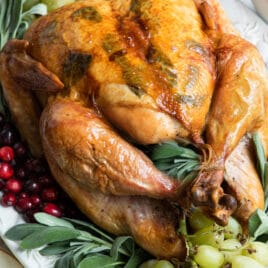
Perfect Roast Turkey
Ingredients
For the turkey:
- 1 (15 pound) frozen turkey thawed, neck, heart, and gizzards removed and discarded (see note 1)
- 1/2 cup kosher salt (see note 2)
- 2 tablespoons baking powder (see note 3)
- 4 tablespoons butter softened, plus 4 tablespoons butter, melted
- 1 bunch fresh sage
- Freshly ground black pepper
- 1/2 cup olive oil
For the gravy:
- Reserved pan drippings from roasted turkey (see note 4)
- 7 cups chicken broth or turkey broth (see note 5)
- 1/4 cup cornstarch (see note 6)
- Salt and freshly ground black pepper
Instructions
To dry-brine the turkey (see note 2):
- Rinse the turkey well inside and out under cold running cold water. Set on a rack set over a rimmed baking sheet. Remove any excess fat or pin feathers and pat dry with paper towels.
- In a small bowl, add kosher salt and baking powder and stir to combine. Sprinkle the salt mixture over the bird. Coat well, stopping before a crust forms (you may not need all of the salt mixture).
- Transfer the turkey to a rimmed baking sheet and refrigerate, uncovered, for 12 to 24 hours (or loosely cover and refrigerate for up to 3 days).
- Remove the turkey from the refrigerator and let sit at room temperature 2 hours prior to roasting.
To roast the turkey:
- Preheat the oven to 425 degrees and place a rack in the lower third of the oven. In a small bowl, stir together the melted butter and olive oil (for basting) and set aside.
- Using paper towels, dry both the inside and outside of the turkey. Gently slide your fingers between the skin and the breast of the turkey to loosen the skin. Spread half of the softened butter between the breast and the skin.
- Arrange twelve sage leaves evenly between the skin and the breast. Place the remaining sage in the cavity. Season with black pepper, including the cavity.
- Truss the turkey, place the bird on it's back, and rub the remaining 2 tablespoons softened butter all over. Place in a roasting pan breast-side up. Pour 1 inch water into the bottom of the roasting pan. Lower the oven temperature to 325 degrees. Roast the turkey for 3 to 3 ½ hours, basting every hour with the butter and oil mixture. Add additional water to the pan as needed.
- Begin testing for doneness after 2 ½ hours. A thermometer inserted into the thickest part of the thigh should reach 165 degrees, and the juices should run clear. Transfer the turkey to the carving board and tent with aluminum foil and allow to rest for 30 minutes.
To make the gravy:
- Place the roasting pan with drippings over 2 burners and turn heat to medium-high. Add broth and bring to a simmer, scraping up the browned bits off the bottom of the pan.
- Pour the contents through a fine-mesh strainer set over a large bowl. Using a large flat spoon, skim off and discard the layer of fat that floats to the surface, or pour the liquid into a fat separator and pour off the liquid, leaving the grease behind.
- Transfer the liquid to a saucepan, place over medium-high heat, and simmer briskly. In a small bowl, add some of the liquid and the cornstarch and whisk together to make a slurry. Gradually whisk the slurry into the simmering liquid, then cook until the gravy thickens, about 5 minutes. Season to taste with salt and pepper.
To carve the turkey:
- On a large cutting board, place the turkey breast side up. Remove the truss. Begin carving one side of the turkey completely before moving on to the other side.
- Removing the wing: Pull the wing away from the body and slice through the skin to locate the shoulder joint. Cut through the joint to remove the wing.
- Removing the whole leg: Pull the leg away from the body and slice through the skin to locate the thigh joint. Cut through the joint to remove the entire leg.
- Separating the thigh and leg: Cut through the joint that separates the drumstick from the thigh. Serve these pieces whole, or carve them by cutting off the meat in thin slices parallel to the bone.
- Removing the breast: Cut along the breastbone while following the curvature of the bones. Using your hand or a carving fork, gently pull the breast meat away while using the knife to remove the meat from the ribs. Place turkey breast on the cutting board. For larger slices, slice the breast meat on an angle.
- Repeat with the second side of the turkey. Arrange cut portions on a serving platter and pass the gravy separately.
Recipe Video
Notes
- Turkey: Look for a turkey with the words “no salt added” on the label. Stay away from “self-basting” or Kosher turkeys which are already injected with a brine. The best (and safest) way to thaw a frozen turkey is slowly in the refrigerator over the course of several days (about 4 days for a 15-pound turkey). Never thaw a turkey using warm/hot water, in the microwave, or at room temperature, all of which let bacteria grow before the turkey is thawed.
- How much turkey: Plan on 1 ¼ pounds per person. If you can’t find a turkey small enough for your group, consider a turkey breast instead. And if you’re feeding a large group, consider a couple of medium or large turkeys rather than an enormous one (it is easier to thaw and cook a couple of average birds rather than the biggest one you can find).
- Kosher salt: Used for dry-brining (aka pre-salting). The salt draws out the extra moisture in the turkey, forms a salt solution on the outer layer of the bird, and then is reabsorbed back into the meat to season it. For a wet-brine recipe, see my post on how to brine a turkey. Don’t substitute standard table salt for the Kosher salt because it is much finer and much saltier.
- Baking powder: Baking powder dries out the outer layer of the turkey resulting in deliciously crispy skin.
- Chicken broth: Homemade chicken broth, or turkey broth, if you’re one step ahead of things. If you like, you can simmer the neck and gizzards in water while the turkey roasts to make a quick version of turkey broth (discard the liver). Store-bought works, too.
- Cornstarch: My trick for making an easy gravy that’s also gluten-free.
- Yield: Plan for 1 ¼ pounds turkey per person (some of the weight is from bones). This recipe assumes a 15-pound bird which will feed about 12 people (about 1 ½ cups turkey per person or 18 cups total). The math is: 12 people x 1.25 pounds per person = 15-pound turkey.
- Storage: Store leftovers covered in the refrigerator for up to 4 days.
- Make ahead: Get a jump start on your Thanksgiving prep with my easy Make Ahead Turkey recipe. Roast, carve, and freeze the turkey in its juices. Then thaw, reheat, and make the gravy.
Nutrition
Leftover Turkey Noodle Soup
Put your leftover turkey to work in this quick and easy Turkey Noodle Soup. It’s simple but delicious and perfect year-round. Also great with chicken!
View RecipeMeggan Hill is a classically-trained chef and professional writer. Her meticulously-tested recipes and detailed tutorials bring confidence and success to home cooks everywhere. Meggan has been featured on NPR, HuffPost, FoxNews, LA Times, and more.
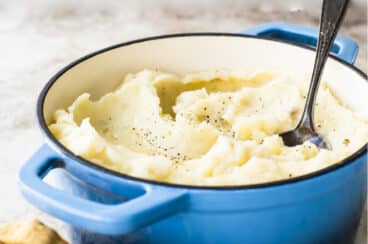
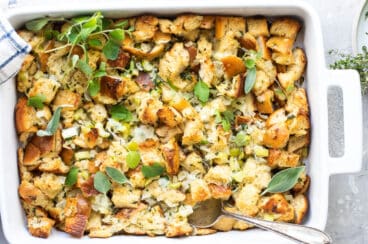
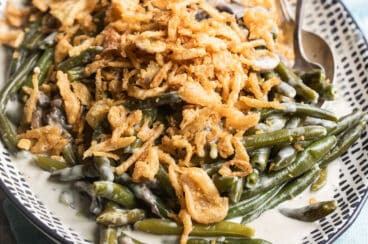
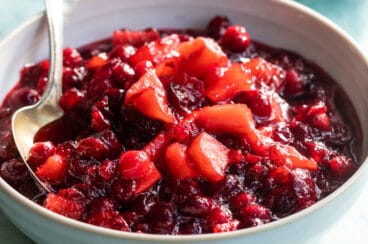
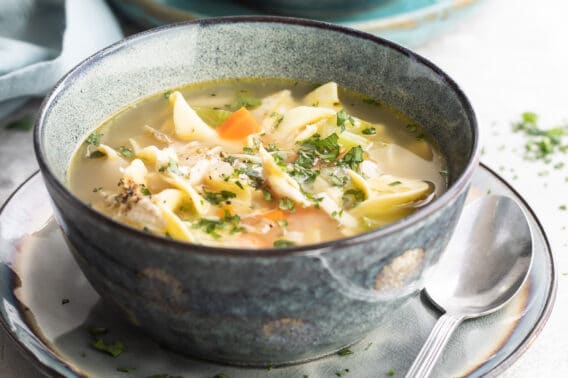
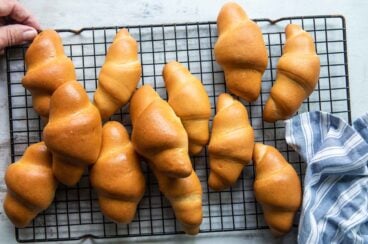
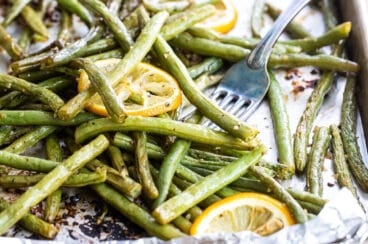
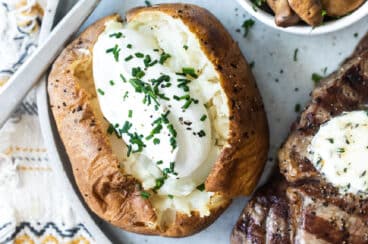
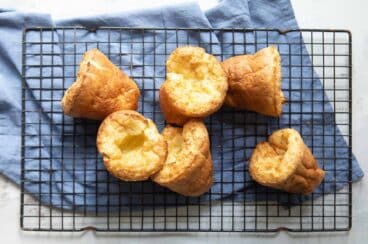
I like turye chicken and very test and healthy and very cranchi I like and recipe is very interesting and very delicious food it’s my favorite dise
Hi Satya, I’m happy to hear you love turkey so much! If you have any questions on it or making a turkey yourself, please write again! – Meggan
After the turkey is brined and has sat for 12+ hours, do I wash the salt off before patting it down with paper towels and spreading the butter on? Thanks.
Hi Erica, thank you for your question! No, the salt does not need to be rinsed off after the turkey is brined. Please write with any more questions! I hope your turkey comes out amazing! – Meggan
The whole meal was amazing! Thank you for your delicious and simple to follow recipes!! Christine
You’re so welcome, Christine! I’m so happy you loved them! Take care! – Meggan
You will have an amazing, amazing turkey if you place the turkey breast side down!!! Please try it! It will really amaze you!!!!
You can’t go wrong with a classic oven-roasted turkey!
Easy way to roast my turkey! The gravy is an awesome bonus too! was delicious
Meggan, in direction number 4 where it says to place the turkey on it’s back and rub the remaining melted butter all over, do you mean the remaining softened butter. We are rubbing it all over the outside of the breast and legs, is that correct? It sounds wonderful. I didn’t want to cook a turkey this year, hoping my son-in-law would share his with me, but this sounds so tempting I may have to cook one after all.
Hi Sue, yes! Thank you for finding that and sorry about the typo. It should be the remaining melted butter. I will fix it right now. I appreciate your support and patience and I hope you love the turkey! Please let me know if you need anything else.
The “How to Dry Brine a Turkey” section states baking soda should be mixed with the salt, however the recipe lists baking powder. Which is correct?
Hi Barb, sorry about that. The recipe is correct! I’ll fix the typo. Have a lovely day!